7 amazing things to see in the New Forest (and where to stay)
Wild horses couldn't drag me away! Run free in the New Forest — and meet the wildlife that calls this landscape their home
Words and pictures by Susie Kearley
We arrive at Holmsley Campsite near Burley, and our first impressions are good — the campsite has a well-stocked shop with a good range of food, toys, and other goodies, check in is easy, and we can pitch wherever we like. We head for a sunny spot and set up.
After a bite to eat we go out and explore the New Forest in the sunshine, stopping at Whitten Pond car park, a short distance from the campsite. The pond is visible from the road and is surrounded by wild horses. We walk to it across heathland, and are greeted by friendly horses, who seem happy to be stroked.
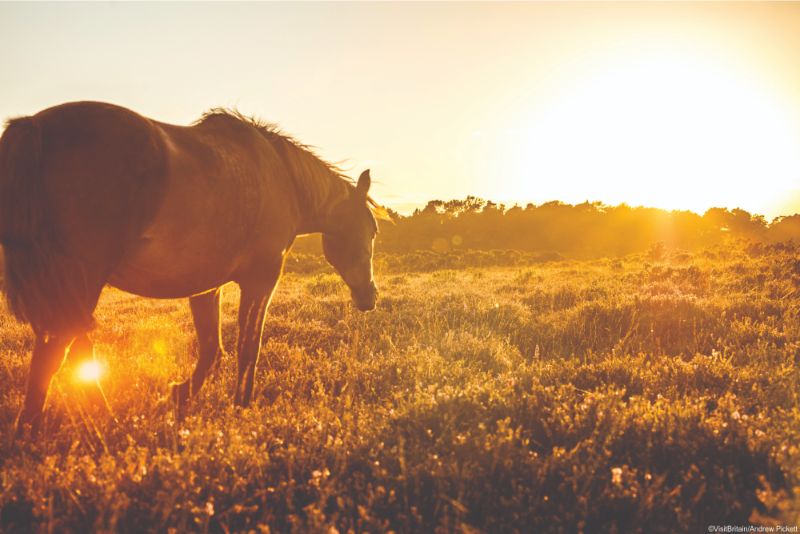
A stroll around the pond leads to a boggy area, where we jump across, and pass a few nervous ponies. Among them is a well-endowed stallion who is neighing loudly. He gallops for short distances across the heath and appears to lead the group.
When the terrain underfoot becomes too wet, we retrace our steps to the car park and head onward to Burley. This quaint little village is best known for its associations with witchcraft.
We head into the witchcraft shop, full of trinkets and ornaments of a witchy nature, and then move on through the various gift shops until we reach my favourite shop, called the Coven of Witches. It's full of beautiful stuff from the realms of fantasy and imagination. Inside, you can buy Harry Potter's wand, a crystal ball, or a sculpted witch's cottage, illuminated by interior lights.
We move on to find more open heathland and horses, and come across a pretty stream running through beautiful countryside, off Mill Lane in Burley. There are dozens of horses and cattle grazing alongside the stream. We walk for an hour before returning to camp for the evening.
Back at Holmsley, I want to make curry in the caravan, but I don't have tomato purée. The campsite shop comes to the rescue. I'm served with such enthusiasm that Vic says, “Perhaps they've never sold a tube of tomato purée before!”
The staff are delightful. The curry turns out fine, and we dined outside in the glorious sunshine. The heat from the sun seems more intense on the campsite and Vic says it's the concrete pitch reflecting the rays. We've certainly chosen a suntrap!
1. Beaulieu
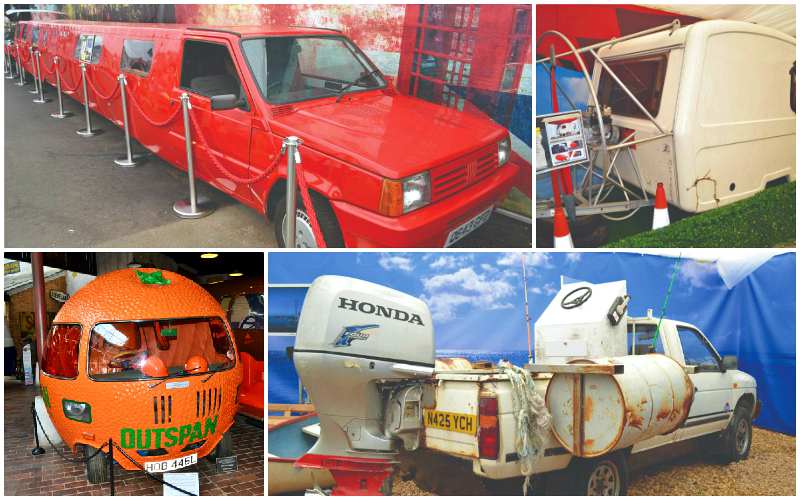
In the morning, we visited Beaulieu, best known for its world-renowned National Motor Museum, and home to Beaulieu Abbey and Beaulieu Palace, the residence of Lord Montagu.
The 'On Screen Cars' exhibition includes Ron Weasley's flying Ford Anglia, Zeo's Jaguar from 007 Die Another Day, Del and Rodney's Robin Reliant, and Mr Bean's Mini.
The Top Gear exhibition piques our imaginations, not least because a modified 'flying' Freedom caravan airship is there. We have a Freedom caravan back at the campsite. We're not huge fans of the show, but as I peruse the cars on display, it makes me want to watch the 'Top Gear Challenges' DVDs.
I've clearly been missing something highly amusing! Some episodes are playing on strategically placed televisions.
Other highlights of the Top Gear exhibition include makeshift stretch limos, handmade by the presenters; a car that's been modified into a submarine; and several handmade amphibious vehicles, one of which actually made it across the English Channel to a beach in France!
The Challenge Gallery is a permanent exhibition and there are new exhibits, too, from the filming with Paddy McGuinness, Chris Harris and Freddie Flintoff.
The main Motor Museum houses prototype vehicles and first models of early automobiles, as well as strange contraptions that inspired the motoring revolution. Among our favourite exhibits is a 1964 Peel P50, a micro car with little room inside. It was made in the Isle of Man and weighs the same as 60 bags of sugar. Top speed: 40mph.
There's also an orange fruit-shaped promotional vehicle used by Outspan, a brewery van in the shape of a beer bottle, and record-breaking land speed cars, as well as sports cars and dozens of other remarkable exhibits.
The upper floors house an exhibition of vintage motorcycles. I'm particularly partial to a beautiful Harley Davidson. Dream on.
The exhibitions are extensive, looking at the history of motoring, the changing roles of garages, and the history of caravanning. There's a miniature caravan presented to Prince Charles and Princess Anne when they were children, alongside one of the earliest horse-drawn caravans.
We take a ride in a moving pod, travelling through the history of motoring. It explores mechanical developments, the impact of automobiles on other road users, shows us street scenes and typical family outings, and we learn about winter motoring, and automobile use in WWII.
There's so much to see in the Motor Museum. There are hundreds of vehicles and abundant historical information, looking at the development of brake technologies, changing approaches to navigation, and the history of tyres.
There are even video games enabling you to challenge the kids to a race track competition. You could spend all day there!
Back outside, we travel on the monorail and the vintage bus, and then visit the abbey. There's not a great deal left of what was once a huge and imposing abbey, but there is an interesting exhibition about the lives of the monks who lived on the estate while the monastery was still standing.
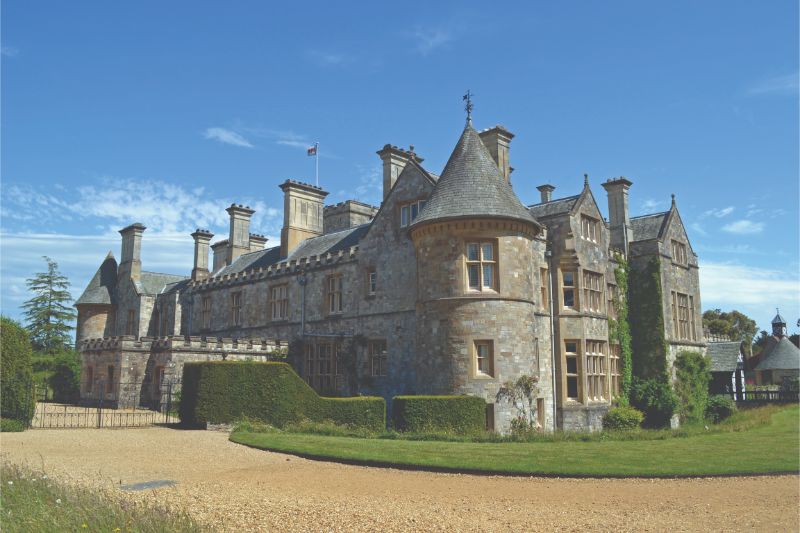
The exhibitions take you through the Abbey one room at a time, explaining what the monks did in each location, and giving a fascinating insight into their lives.
Next we visit the palace, home to the Montagu family. The 3rd Lord Montagu founded the Motor Museum in 1972. He passed away in 2015, leaving an incredible legacy. Some rooms are stunning, with gorgeous vaulted ceilings and ornate décor.
We see the entrance hall, library, drawing room, two dining rooms, reception rooms, and the 'Secret Staircase' to the roof — which, sadly, is not open to the public.
We have a look at the WWII exhibition, and then walk back along the riverside, passing through the beautiful gardens.
2. Buckler's Hard
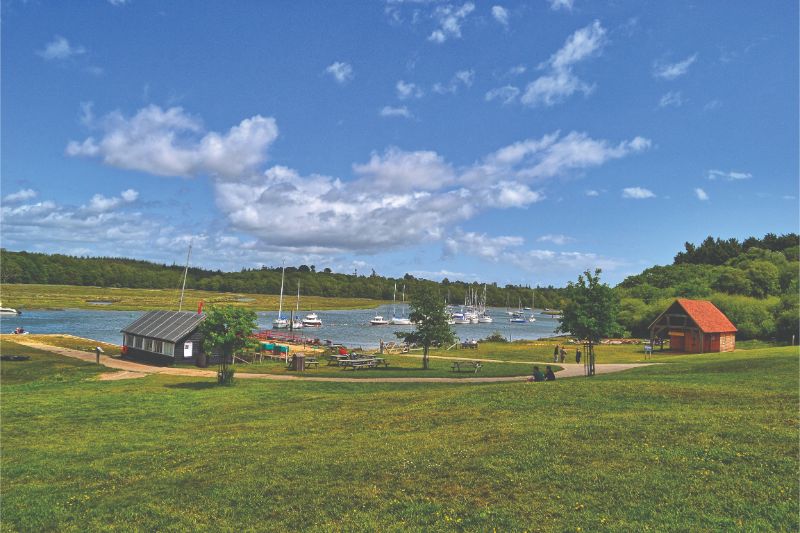
Our destination the next day is Buckler's Hard, an old ship building yard, where, in the 1700s, ships of all shapes and sizes were constructed. The land, which was owned by Lord Montagu of Beaulieu, was leased to Mr Adams, who, with the help of his family, ran a ship building business from Buckler's Hard.
Parts of the old village are still occupied today.
The main attraction at Buckler's Hard is the Maritime Museum, which takes you through the history of the boatyard, detailing the ships they built, and the lives of the people who worked there. A reconstructed cottage shows how a labourer's family would have lived back then.
The museum also houses an exhibit of an eighteenth century pub, information about Buckler's Hard's role in WWII, and a gallery about the sinking of the SS Persia — the 2nd Lord Montagu was on board. Fortunately he survived, but many others on the stricken vessel perished.
Outside, among the village's surviving cottages, is the reconstructed house of a professional ship builder, who enjoyed a better standard of living than the labourers working at the yard. There's also a small church and a pub serving drinks and plenty of tasty food.
We take a boat trip along the river and it's so windy, it's hard to hear the commentary! We pass where the labourers once lived, learn a bit about the oyster beds and oyster farming, and hear about the salt lagoons, where sea water was dried to create salt for cooking and preservation. After disembarking, we follow the riverside path to Beaulieu village. It's tiny and quaint, but somewhat spoilt by queues of cars.
Buckler's Hard provides a great day out for maritime enthusiasts. There are no big warships, like other historic dockyards, but if you're into maritime history, you'll find the museum fascinating.
Access to the village and waterside is free. You can enjoy a pint in the olde worlde pub, join the boat trip along the river, go kayaking, or choose from several walking routes.
Before returning to camp for the evening, we stop at Hatchett Pond, where donkeys are grazing on the gorse, pestering people in vehicles for food, and being petted a lot. The pond is beautiful, and we sit on the bank for a while, watching a swan glide across the water with her cygnets. It's worth a visit if you have time.
3. Hurst Castle
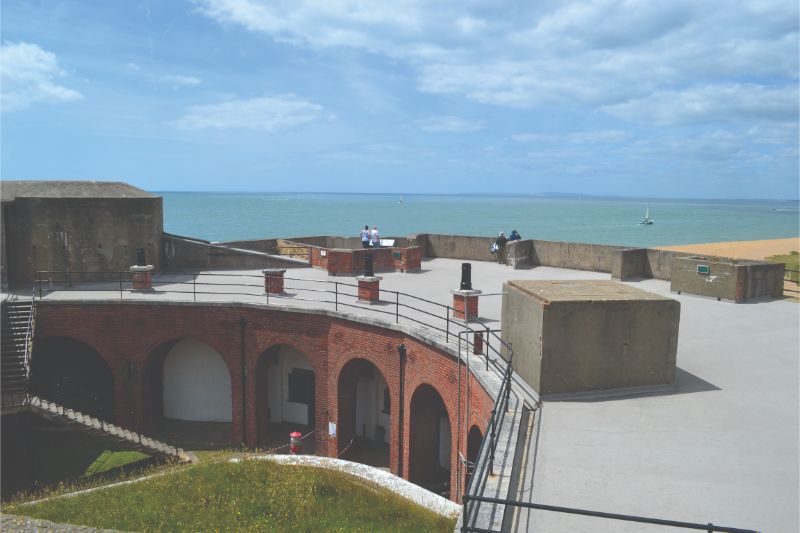
The following morning, we head to Hurst Castle, located on a spit of land in the middle of the sea, just south of New Milton. There's a ferry to the castle, or those who are reasonably fit can walk the 1.5-mile distance across shingle, which separates the Solent from the English Channel.
We walk it in about 40 minutes and time passes quickly because there's plenty to see en route: boats, wildlife, amazing landscapes, and rocky barricades designed to protect the spit from coastal erosion.
The castle houses a series of exhibitions. One is about Hurst Spit, the wildlife that depend on it, and what would happen if the spit were washed away.
Firstly, the salt marsh nature reserves would be devastated, and the castle would become an island. Properties along the coastline would become vulnerable to flooding, Milford would flood, and the Isle of Wight could suffer from considerably worse erosion. There's a 50-year action plan in place to prevent this from happening, detailed in this exhibition.
Many of the old military barracks house exhibits about wars through the centuries in which Hurst Castle mounted a defence. A few rooms are dedicated to the history of lighthouses, and there's a reconstruction of the Isle of Wight's Needles Lighthouse kitchen.
Many of the former ammunition stores are open, and what the castle lacks in furnishings, it makes up for with a host of diverse displays.
The castle was built in phases — parts are Tudor and parts are Victorian. We enter the original castle built by King Henry VIII, which houses a wealth of information about war and conflict over the centuries.
In the heart of King Henry's castle is a round room, where the gunpowder was kept in barrels. There are plenty of opportunities to climb onto the roof and walk along the wing batteries, to see fantastic views of the Solent, the Isle of Wight, and surrounding rolling countryside.
One of the charms of this castle is little is out of bounds. Many of the rooms are empty and uninviting, but you can explore almost every nook and cranny, climb most of the staircases, and get views from most of the towers. If you're a history buff, you'll love the exhibitions. If you're not, you might still pick up a thing or two as you glance at the highlights.
We leave the castle and stroll along the beach, admiring the boats on the Solent, before heading back along the spit. Back at camp, we're due to move on. It's been a lovely few days.
We've paid a small fee to stay until 5pm, and now we're moving to another site near Brockenhurst.
4. Deer and Ponies
We arrive at Long Meadow campsite, near Brockenhurst and are charmed by the location before we've even reached the campsite gate. There are dozens of deer with huge antlers in a field near the campsite, and as we approach the gate, a pony and foal come running up to say hello. It is such a delightful welcoming committee!
Long Meadow campsite is smaller and quieter than the last. It offers views across fields and immaculate lawns. I visit the washrooms and find them modern and sparklingly clean. Even the hand dryers emit a space-age electric blue glow!
Suitably impressed, we cook some dinner, plan the events of the next few days, and then go for a walk to see the deer and the foals.
5. New Forest Wildlife Park

Morning dawns and the sun is out, so we headed off to the New Forest Wildlife Park for a day of animal encounters and wildlife delights.
The park has a large collection of otters and owls, as well as deer, wolves, lynx, buffalo, wallabies, pigs, Scottish wildcat, pine martens, foxes, ferrets, harvest mice, a butterfly house, and even a hedgehog!
The otters are playing fun and games in the water, with one otter enclosure sounding like a chorus of dogs' squeaky toys. The otters are excited as they await their 11.30am feed. One of the otters is juggling with a stone! He needs a bit more practice, but it's amusing to watch.
We meet a deer who is remarkably friendly and after checking out a pushchair for anything edible, he proceeds to chew my trouser pocket! This deer wins us over and accompanies us to see the South American giant otters, the Scottish wildcat, and the pine martens.
The park has a wide selection of owls, with one snowy owl sat on a ground nest. It also has an albino wallaby with a wriggling new arrival in her pouch, and an extensive adventure playground, which, in the absence of children, we have to test for ourselves!
Fortunately, adults are allowed to participate, and the climbing rigs are excellent. The zip rope provides a good ride too, even if Vic does want to get off prematurely.
Having covered most of the park in the morning, I can recommend a morning visit, since the animals seem livelier, noisier, and less likely to be hiding before lunch. They're not as lively on our afternoon recap of the highlights. There's a lovely café on site if you want to grab a bite to eat.
We finish by 2pm and spend the rest of the afternoon seeing what some local villages have to offer: Lyndhurst, New Milton and Brockenhurst. Lyndhurst has a camping and outdoors shop that would appeal to caravanners.
Eating out
The Paddle, Highcliffe
This stylish little café is a favourite with locals and visitors alike. Serving up plenty of homemade dishes, you can warm up with a bowl of soup in the colder months or enjoy a hot chocolate.
W thepaddle.co.uk
Mr Eddy's Tearooms, Exbury
Take a break from exploring the gardens with a pit stop at this lovely restaurant.
The catering is provided by Searcys, a group founded in 1847 by John Searcy, pastry chef to the Duke of Northumberland. You'll also find Searcys' restaurants at some of London's finest spots.
W exbury.co.uk
The Yachtsman, Hamworthy
Close to both swanky Sandbanks and Poole Harbour, you'll get some cracking views when you sit here and enjoy a pint. A real family pub, you can expect good pub grub and a traditional Sunday roast if you don't want to cook.
W yachtsmanhamworthy.co.uk
6. Brownsea Island
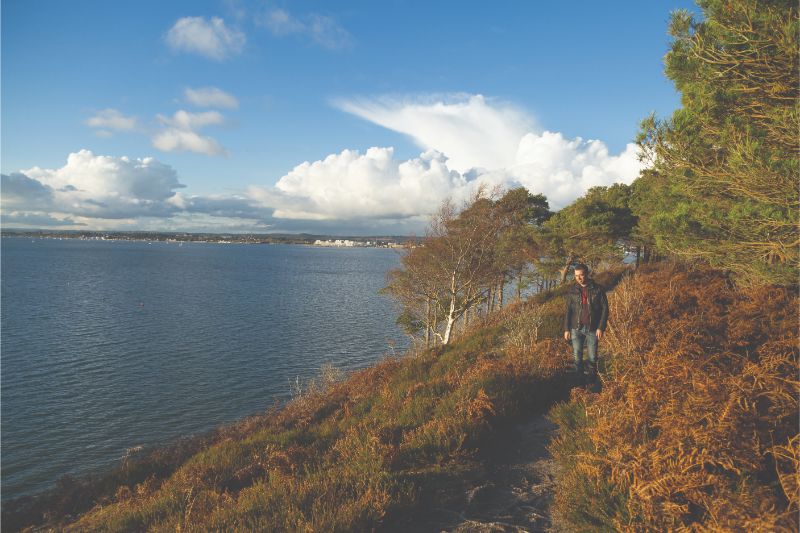
Brownsea Island is always a favourite haunt when we visit this part of the world. It's home to a thriving population of red squirrels, and free-range chickens on the loose — there are no predators to feast on them! It's just 1.5 miles long and three-quarters of a mile wide.
There are tracks around and across the island, as well as some beautiful beaches. We follow a path, spot a red squirrel, and then discover the kids' adventure playground, made entirely from logs. The highlights of the playground include a racing car, a dugout canoe, a see-saw, and a game of snakes and ladders.
At the far end of the island is a slope down to a beach. It's totally deserted and I feel like I'm in a scene from Robinson Crusoe. There are no footmarks, and no sign of human exploration — just a load of dead giant jellyfish.
They get washed up on the beaches during storms and apparently this large species, which looks a lot like something out of Doctor Who, has entered British waters in search of plankton, which are thriving.
We walk along the beach and then head back up to the main path, where we see the remains of the former pottery and brickworks that operated from Brownsea Island in Victorian times.
There was once a small community on the island, but today the only occupants are wardens, visiting scouts and guides, and employees of the John Lewis Partnership — the company leases the castle as a holiday destination. There's a scout campsite, where Lord Baden-Powell held the first scout camp in 1907, and a National Trust house used by many scout groups.
After walking through woodland, we take a diversion onto a beach. It's well-trodden, but not busy. A peacock approaches people on the beach and it's a bit surreal.
Back on higher ground, we spot more red squirrels. The visitor centre is showing a series of videos about the history of the island and the red squirrels. We catch a ferry back to the mainland and drive along the coastal roads on our way back to camp.
7. Exbury Gardens and Steam Railway
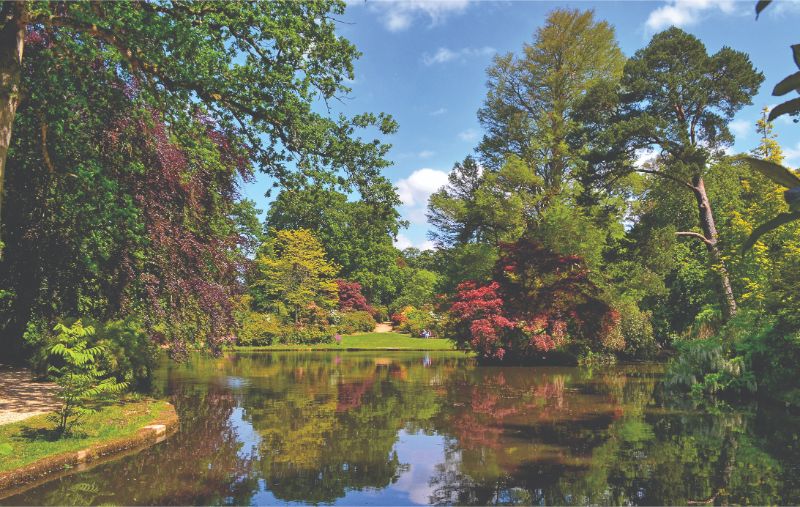
On our last day, we visit Exbury Gardens, a peaceful, serene and enchanting attraction, full of glorious blooms. It has a large collection of ancient exotic trees, beautiful lakes and a cascade, as well as a little steam train.
Originally created by Lionel Nathan de Rothschild in the early 20th century, the vision was to have a garden of plants from around the world that would provide a change of scenery at every turn. He aspired to “create one of the finest woodland gardens in the country”, and he certainly achieved something entirely enchanting.
We arrive on a sunny morning, and follow a path to the herbaceous borders, which are bursting with colour. We pass Exbury House, a private residence, and continue through the gardens, seeing a large bell hanging from a tree. Floral pathways lead to a pond, home to dozens of koi carp and a replica of Monet's iconic bridge.
There's a Riverside Walk and a Winter Garden. We follow a path leading to pools, a cascade, and a glorious arrangement of colourful blooms. There's loads to see including the Sundial Garden, the Daffodil Meadow, and the stunning Iris Garden.
The café offers a good selection of produce, so we stop for lunch. Then refreshed, we go to see the wildlife ponds, bog garden and rockery. There's an American Garden, Jubilee Ponds and a Hydrangea Walk, too.
A train departs from the steam railway at 1pm, and we ensure we're on board. It takes us to parts of the garden that we wouldn't otherwise see. For that reason alone, it's worth the extra fee. The train ride lasts about 20 minutes and is intended for all ages.
We see sculptures and art en route, and during the brief station stop, at Exbury North, we hear all about the gardens' Royal connections. The Queen and Prince Philip used to be regular visitors. They'd don their working clothes and help out.
On one such occasion, a member of the public saw the Queen gardening, and told her that she looked remarkably like the Queen of England. She replied, “That's very reassuring”. The train ride is great fun, and it's an excellent conclusion to our day.
We return to camp and pack up in great haste, as we're supposed to be away by 2pm — an extension! We're a few minutes late getting away, but no one seems to mind. It's been an amazing holiday and the sun is still shining! Bring on the next break!
Where to stay
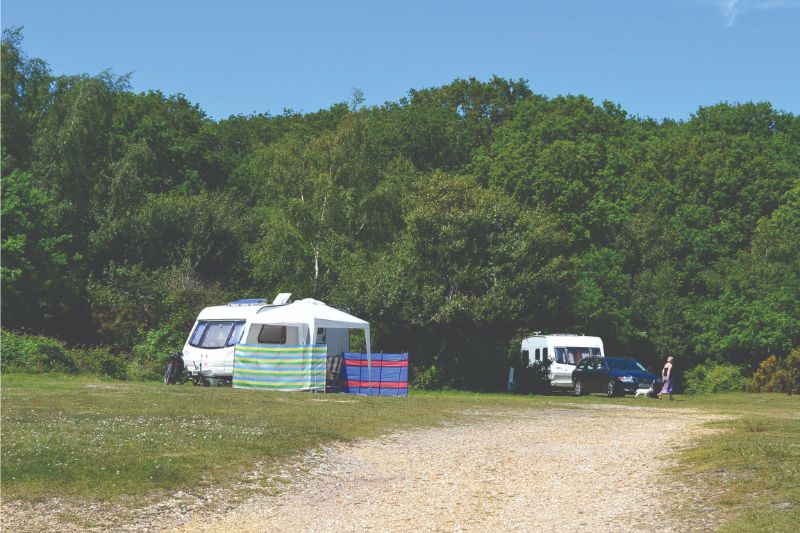 Holmsley Campsite
Holmsley Campsite
Forest Road, Christchurch, BH23 7EQ
T 024 7642 3008
W campingintheforest.co.uk/england/new-forest/holmsley-campsite
OPEN 11 April to 4 November
PRICE From £16.95
Holmsley Campsite is well-kept with clean showers and washrooms, with toasty hot water. There's a kid's play area, a great shop, and we receive excellent service.
The site is in a beautiful location in the heart of the New Forest, and just outside the gates is heathland where ponies and foals graze.
The site is located on part of an old WWII airfield and there are information boards and photos showing the history of the site which makes for fascinating reading whether you're a history buff or not!
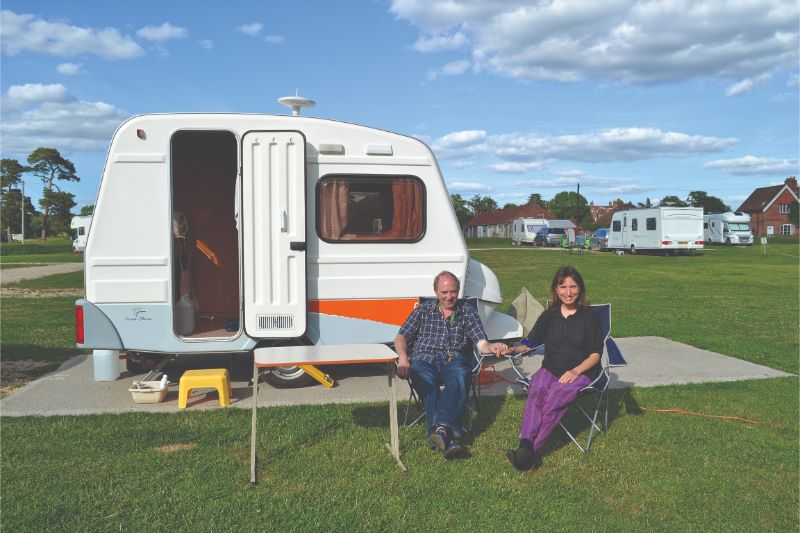 Long Meadow Campsite
Long Meadow Campsite
New Park, Brockenhurst SO42 7QH
T 01590 622489
W longmeadowcampsite.com
OPEN 4 March to 31 October
PRICE From £24
Long Meadow campsite is small, friendly, modern and clean. You can choose from hardstanding pitches or a grassy field. There are 28 electric hook-ups available. Dogs are welcome.
Among the most delightful aspects of the campsite is that deer roam freely, and sometimes, they're just outside our caravan. There's a lot of recycling here, including a food waste bin. The showers are by push-button operation, and it's all modern and pristine.
 Setthorns Campsite
Setthorns Campsite
New Forest, New Milton, Hampshire BH25 5WA
T 024 7642 3008
W campingintheforest.co.uk/england/new-forest/setthorns-campsite
OPEN All year
PRICE From £17.93
This campsite has 237 pitches set in woodland glades. It's a wild experience – there are no toilets or showers at the site, so you'll need to use your own. Hardstanding and electric hook-up pitches are available.
There are drinking water taps and chemical disposal points. There are no dish-washing facilities, but pets are most welcome!








Recent Updates
Caravan showers: all you need to know
In this guide, we’ll discuss the different types of showers, how they work, and how to fit an external shower point to your caravan ...
Caravan towing: all you need to know
Towing a caravan may seem daunting initially, but a few simple tips can make the journey enjoyable and ...
All you need to know about towbars & towballs
Flange, detachable, swan neck, retractable – towbar technology choice is bewildering. Don’t worry. We’ll ...
Caravan WiFi: everything you need to know
Caravan holidays are the ultimate way of getting away from it all, although we sometimes need a link to the ...
Caravan insurance: all you need to know
Navigating the world of caravan insurance can feel like a daunting task. Fear not, as this comprehensive ...
Buying a caravan: what you need to know
Let us guide you through some of the complicated things to think about when first looking at buying a ...
Caravan awnings: a buyers' guide
Caravan awnings are a fantastic addition to any caravan as they are one of the simplest, quickest and most ...
Caravan electrics: avoid tripping out
All caravan owners have overloaded their mains supply at some time. Here’s how to master caravan electrics ...
Caravan heating systems: a quick guide to caravanning warmth
When winter is here, you’ll be glad of a decent caravan heating system if you’re out touring. Here’s how the ...
Caravan damp: a complete guide
There's little more guaranteed to strike fear into the heart of a caravan owner than the word 'damp'. But if ...
Other Articles
Caravan jockey wheels: the definitive guide
A well-functioning caravan jockey wheel can make all the difference to manoeuvring away from the towcar, especially if you don't have a caravan mover ...
Caravan cooking recipes
Caravan cookery inspirational ideas. No need to stress out in the kitchen with these quick and easy ...
Caravan bike racks: a complete guide
Exploring the beautiful surroundings while on a caravan trip is undeniably one of the greatest joys of the ...
A guide to solar power in your caravan
Not that many years ago, mains electrical hook-up on campsites was considered a bit of a luxury, and, for ...
The ultimate guide to caravan layouts
Choosing the right layout or floorplan of your caravan is an all-important part of the buying process – find ...
A guide to seasonal caravan pitches
Our in-depth guide to finding and securing seasonal caravan pitches on your favourite campsite ...
Caravan weights and payloads: a quick guide
The terminology of caravan weight – MIRO, MTPLM, noseweight, kerbweight, payload, weight plate upgrade – is ...
The ultimate guide to caravan motor movers
Caravan motor movers: everything you need to know about remote control caravan manoeuvring ...
Caravan cleaning: All you need to know
Whether you’re taking the caravan out for the first time or it’s just in need of a spruce up, our guide will ...
18 essential items for camping with your dog
Camping is for the whole family – including our four-legged members. Here's what you'll need to keep your dog ...